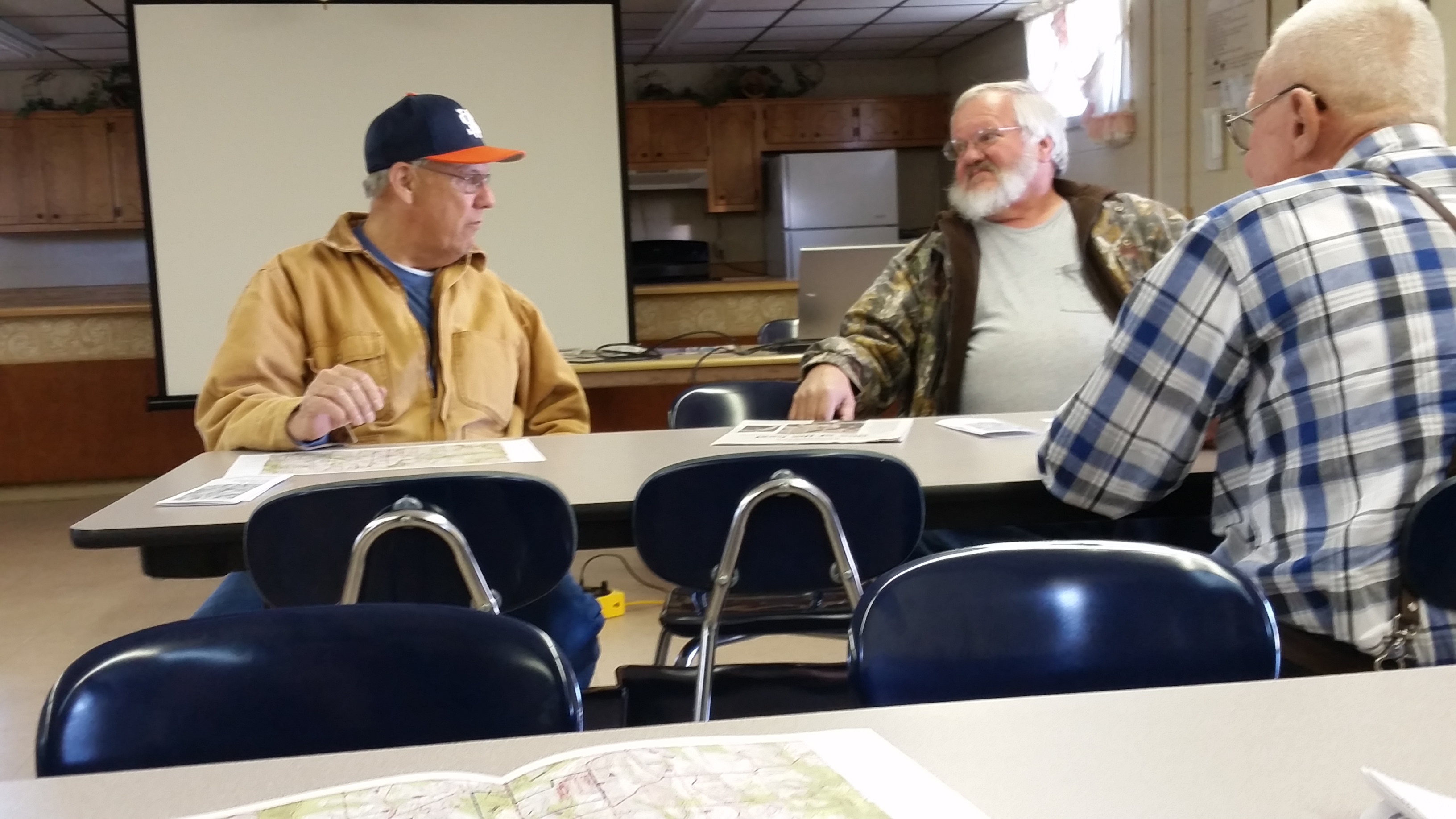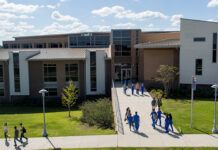BERLIN – The community of Berlin took the first step toward incorporation on Saturday, when an open house was held at the Berlin Community Center from 2-7 p.m. Residents were invited to drop in to get information and, if they live in the initial incorporation area, sign the petition for incorporation. The first signature on the petition expires in 18 months, meaning the next year and a half will be a busy one for the small community centered around the intersection of U.S. Highway 278 and County Road 747, known as Walker's Corner.
So who is allowed to sign the petition and how many signatures are needed? Those who live in the initial incorporation area (outlined in blue on the map graphic) are the only residents who can sign. As far as the number of signatures, there’s not an exact number, but rather a percentage. Within the blue area, 15 percent of registered voters must sign the petition to move the incorporation process forward.
As for how the blue area was selected, the law states that there must be four registered voters per quarter mile of the entire, contiguous area. In fact, the blue area is now a bit smaller than it was just last week, as a community member passed away, leaving only three registered voters on her particular quarter mile, meaning that the four subdivisions on the other side of her land are now cut out of the area. Estimates are that those subdivisions house anywhere from 300 to 700 people.
Community member Patrick Bates, who has taken the lead role in driving the incorporation efforts forward, led the open house on Saturday. A lifelong resident of Berlin, Bates researched and produced an informational pamphlet, presentation and several maps showing the exact area that will be targeted for the initial incorporation.
“Berlin is one of the oldest, most densely populated communities in Cullman County that remains unincorporated,” said Bates.
And how many people actually live in Berlin? Bates says that the voting precinct area is 16 square miles with somewhere between 2-3,000 people; however, the incorporation at first will only involve around 2 square miles. He estimates that area includes between 600-1,000 residents. "I think we'll fall above the Vinemont and Holly Pond range, size-wise."
According to Bates, a significant amount of tax revenue collected from residents of the Berlin community is redistributed elsewhere due to Berlin being unincorporated.
Bates said, "There's other people in the community that want this (incorporation) for other reasons, but my main reason is financial. We pay into taxes and that money gets redirected elsewhere. We want them to benefit our community."
He says that the first question everyone asks him is "How much are my taxes going to go up?" According to his research, he said, "They shouldn't go up at all. We already pay the taxes. They're just going to other things in the county. Incorporating would mean that money would go into our town."
Berlin resident Marilyn Bolte, who says she’s lived in the community “for 67 years, born and raised,” said, “This would have been done a long time ago if I had known how to do it. I’m all for it. I’ve said all along that we need to do this. We need a playground. We need things for our community, things we can use.”
Regina Johnson agrees with Bolte, although she says she has “mixed feelings.” When asked why, she said, “I have mixed feelings that it will actually happen. I’d like to see more here. A bank, a post office. I want Berlin to prosper. That’s what I want to see. We need jobs. That’s why I started my own business. I’d like to see a playground, walking trails or a kiddie park. I’d like to see more family time come from this. I’d like to see a grocery store.”
“I think we need the money. We need all of the things that everyone else has,” said another resident.
“It would be nice if we could incorporate. We sure could use some roads fixed,” said yet another.
By about 5 p.m., about a dozen people had stopped by, one of whom lived in the blue area and quickly signed the petition. Everyone else lived in Berlin, but not inside the area.
Talk among the ones gathered then turned to the condition of the community’s roads and the fact that, if incorporated, Berlin would have to take care of all of its own roads, except for U.S. Highway 278. One gentleman, on the fence about his opinion of the move, questioned whether or not the tax money that would come into the town would cover the cost of road maintenance. “We don’t even have any equipment for that,” he said. Others pointed out that the other municipalities in the county were able to maintain their roads.
Here are some facts and figures that Bates compiled for consideration.
Sales Taxes
Cullman is unique in that sales taxes are uniform across the county at 8.5 percent (exceptions being the City of Cullman, Fairview and Dodge City, which have an additional 0.5%). A $100 purchase made most anywhere would be subject to $8.50 in sales tax and distributed roughly as follows:
State of Alabama 4.00
County Schools .50
Cullman County and Agencies 1.80
City of Cullman 1.80
Other Municipalities .40
The tax revenue for other municipalities is split among them based on population. With a population of only 500, in the last three years Berlin would have received:
FY 2013 148,924.46
FY 2014 155,656.01
FY 2015 169,692.60
Total 474,273.07
Bates also cites additional population-based taxes that would provide revenue to Berlin, such as gasoline taxes and payments made by TVA in lieu of property taxes.
Projected Revenue
Thanks to data available for the various taxes, according to Bates, it is possible to estimate the revenue Berlin would have received from the major sources during the 2015 fiscal year:
Population of 500
Sales Tax 169,692.60
TVA Payments 14,877.71
Gasoline Tax 6,545.78
Total 191,126.09
Population of 1,000
Sales Tax 323,819.92
TVA Payments 29,195.61
Gasoline Tax 12,836.64
Total 365,852.17
Population of 1,500
Sales Tax 464,429.68
TVA Payments 42,956.93
Gasoline Tax 18,887.17
Total 526,273.78
If the incorporation happens, Berlin will face the one required duty of a town: road maintenance. That includes everything from repaving, patching and mowing. The town could contract with Cullman County or solicit bids for the jobs. The Berlin community contains between 20 and 30 miles of public roads, not including U.S. Highway 278.
Besides the financial benefits, Bates says the second biggest positive would be parks and recreation. "Right now we have no public parks. We could have parks or playgrounds for families and walking trails. We do have the ball field, but that's it." Alabama law provides for towns to operate a variety of public grounds, he says.
Another area a newly incorporated Town of Berlin would face is public safety. Bates thinks the town could consider contracting with the Cullman County Sheriff's Office and the Berlin Volunteer Fire Department to improve services. The town could also apply for its own ISO PPC fire rating, potentially receiving a rating lower than the fire coverage district at large. “The other municipalities have maintained their volunteer fire departments,” said Bates. “We would do that as well.”
There was a lot of praise for the Berlin Volunteer Fire Department. “It’s one of the best, if not THE best, fire departments in the county,” said a community member.
So what are the next steps?
- Petition Drive – The petition drive, happening now, is expected to take several months, but cannot be longer than 18 months.
- Incorporation Vote – The vote on incorporation will take place about 3-6 months after petition is turned in to the Cullman County Probate Judge. Only people within in the incorporation area can vote.
- Town Census – After a successful vote for incorporation, a town census will be conducted for the purpose of determining revenue distribution.
- Council Election – About 1-2 months after the census, election will be held to elect the first mayor and town council (five members) for the Town of Berlin.
For more information, visit http://berlinal.org/.




















